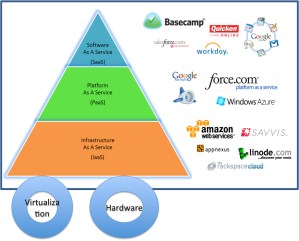Computing Industry is moving from specialization to vertical integration and consolidation. There are numerous examples of this including Oracle buying Siebel and then Sun (Database to Applications to Hardware), Cisco getting into Computing and Applications besides Networking, HP buying EDS and 3Com and now VMWare buying Zimbra after Springsource. Is this good for the industry in general or are we in a phase which will end with disintegration in few years? Is VMWare move a good one for its customers, shareholders, employees or just for the acquired companies?
Quick overview of Cloud Computing – IAAS, PAAS, SAAS
Just to clarify an often confused term Cloud Computing, here is a diagram from www.openadc.org that captures its meaning for me.
Its components are:
- Infrastructure that includes Virtualization; an area VMWare leads today
- Infrastructure as a Service IAAS; a service offering to provide elastic renting of computing resources; an area Amazon leads today
- Platform as a Service PAAS; a service offering to provide an application development and hosting platform; an area where there is no clear cut leader today but many contenders
- Software as a Service SAAS; a service offering to provide various software applications offered as a monthly service; an area where Salesforce is the leader today
VMWare is a leader in the infrastructure market which has a good growth prospect but with renewed focus from Microsoft and commoditization of the area, it is a smart move for VMWare to look elsewhere for growth while continuing to defend its leadership position.
Industry Leaders in Infrastructure, IAAS, PAAS & SAAS
In the area of IAAS, VMWare is losing the battle as companies like Amazon and Rackspace are adopting alternate software. VMWare has some wins with Terremark and Saavis but nothing significant in terms of installed base to justify a leadership position.
Regarding PAAS, the criteria for developers to pick one PAAS over another includes marketing help and ease of development. Most software developers also want independence and so selecting any one PAAS limits freedom for developers and that is why PAAS won’t be a big market any time soon. In the area of PAAS, there are many contenders including Salesforce’s force.com, Google’s less than stellar attempt at AppEngine and Microsoft’s Azure and VMWare’s purchase of Springsource.
SAAS is the brightest spot of this market and the fastest growing segment not just for SMB but now is being adopted by larger enterprises as well. So, VMWare buying anyone in that space makes sense from a segment perspective. Why Zimbra? It is true that most corporate customers want to adopt a hosted communication solution but Zimbra has only one leg of it while its competitors like Cisco, IBM, Microsoft and Google have a much bigger piece and vision.
Zimbra and VMWare – Entry into Unified Communications?
Zimbra already owns a piece of the market, has a good email product and will probably get more attention at the hands of VMWare whose focus, unlike Yahoo, is business customers. However that market is moving to Unified Communication an area where voice and email merge and require a different mindset. Moreover that will put VMWare’s Zimbra products in competition with its partners IBM and Cisco. VMWare will achieve initial success in this business as Zimbra had been a stepchild at Yahoo but can it really make a long-term success of this business?
Conclusion
VMWare virtualization customers are worried if this new move will defocus the company. Needless to say executive attention at VMWare will get divided but considering VMWare’s current lead in virtualization, they have very little danger of being displaced short term. However, longer term, virtualization is heading down the path to commoditization and so VMWare has no choice but to go up the stack. However, the issue remains whether VMWare can manage to lead at all these layers like Microsoft or will just be an “also ran” at other layers while endangering its current lead in virtualization with defocusing and inviting new competitors who are its current partners.
R. Paul Singh
